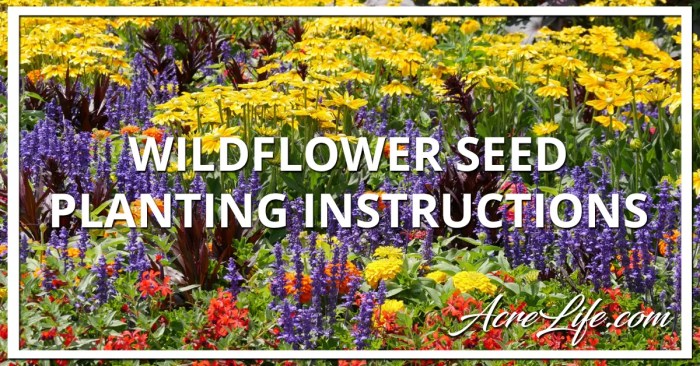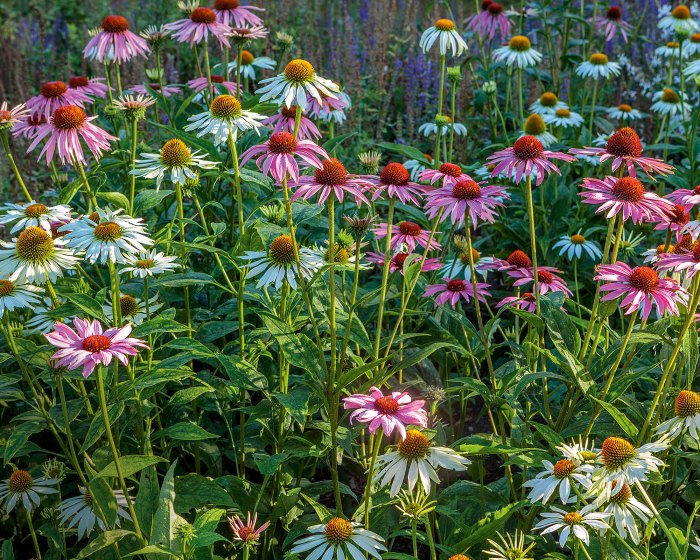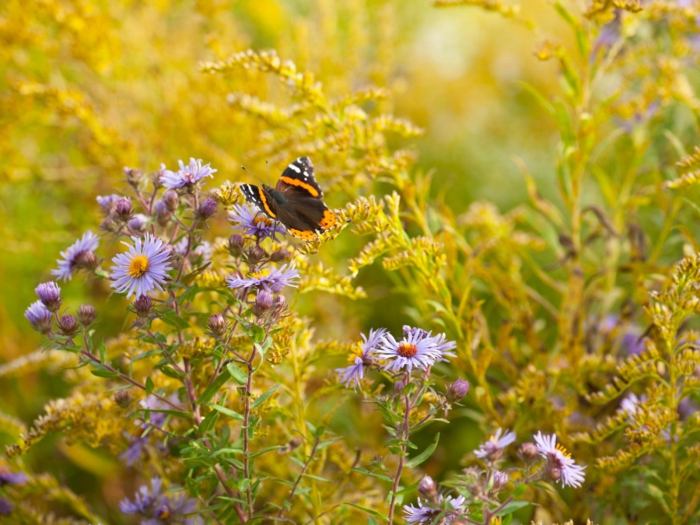Can You Plant Wildflower Seeds in Fall?
Best Time for Planting Wildflower Seeds
Can you plant wildflower seeds in fall – Choosing the right time to plant wildflowers significantly impacts their success. While spring planting is common, fall planting offers several advantages, particularly in many temperate climates. This section will explore the optimal timing for fall planting, contrasting it with spring planting, and detailing ideal conditions for germination.
Fall Planting vs. Spring Planting
Fall planting provides several benefits. Seeds often experience natural stratification over the winter, mimicking natural conditions and improving germination rates. Moreover, fall-planted wildflowers can establish strong root systems before the spring growing season, leading to more vigorous blooms. However, fall planting also presents challenges. Harsh winter weather can damage or destroy seedlings, and germination success depends heavily on soil conditions and the species selected.
Spring planting, conversely, offers a more predictable growing season but might result in slower establishment and increased competition from weeds.
Ideal Conditions for Fall Wildflower Germination
Successful fall wildflower germination hinges on suitable soil temperatures and weather. Ideally, soil temperatures should be consistently cool, between 40°F and 60°F (4°C and 16°C), to promote seed imbibition and early root development. Avoid planting during periods of freezing temperatures or prolonged drought. Consistent moisture is crucial, but avoid waterlogged conditions which can lead to rot. A period of mild, moist weather following planting is optimal.
Germination Rates of Wildflower Species
Germination rates vary considerably among wildflower species, and fall planting success depends heavily on species selection. While some species germinate readily in fall, others require spring planting for optimal results. For instance, California poppies ( Eschscholzia californica) often germinate well in fall in mild climates, while black-eyed Susans ( Rudbeckia hirta) may exhibit better germination rates in spring. Detailed species-specific information is crucial for planning a successful fall wildflower garden.
Seed Selection and Preparation
Selecting the right seeds and preparing them appropriately are crucial steps for a successful fall wildflower planting. This section covers choosing suitable species, preparing seeds for planting, and utilizing pre-made wildflower seed mixes.
Wildflower Species Suitable for Fall Planting

Source: acrelife.com
| Species | Hardiness Zone | Bloom Time |
|---|---|---|
| Black-eyed Susan (Rudbeckia hirta) | 3-10 | Summer-Fall |
| California Poppy (Eschscholzia californica) | 6-10 | Spring-Summer |
| Cornflower (Centaurea cyanus) | 2-9 | Summer |
| Cosmos (Cosmos bipinnatus) | 2-11 | Summer-Fall |
| Sweet Alyssum (Lobularia maritima) | 3-10 | Spring-Summer |
Preparing Wildflower Seeds for Planting
Seed preparation often involves stratification, a process that mimics the natural cold period seeds experience before germination. This is especially important for species that require a cold period to break dormancy. Some seeds benefit from scarification, a method that weakens the seed coat to improve water absorption. Always check the seed packet for specific instructions, as pre-treatment requirements vary widely among species.
Wildflower Seed Mixes for Fall Planting
Pre-mixed wildflower seed blends designed for fall planting offer convenience and diversity. These mixes typically contain species adapted to specific climate zones and bloom times. Look for mixes that specify “fall planting” or “autumn bloom” on the packaging. Some mixes focus on attracting pollinators, while others highlight specific colors or plant heights. Carefully read the mix composition to ensure it suits your local climate and desired aesthetic.
Planting Methods and Techniques

Source: futurecdn.net
Several methods can be used to plant wildflower seeds in the fall. Proper soil preparation is also vital for success. The following section provides a detailed step-by-step guide for planting.
Methods of Planting Wildflower Seeds

Source: futurecdn.net
- Broadcasting: Scattering seeds evenly over the prepared soil surface.
- Drilling: Sowing seeds in shallow furrows using a seeder or hand tool.
- Spot Seeding: Planting seeds individually in specific locations.
Soil Preparation
Before planting, tilling the soil to a depth of 6-8 inches improves aeration and drainage. Amending the soil with compost or other organic matter enhances fertility and water retention. Raking the soil smooths the surface and creates a suitable seedbed. Remove any rocks or debris that might hinder germination.
Step-by-Step Guide for Fall Wildflower Planting
Step 1: Image 1: Shows the preparation of the soil, including tilling, amending, and raking. The image emphasizes the creation of a fine, level seedbed.
Step 2: Image 2: Shows the scattering of seeds across the prepared soil. The image emphasizes the even distribution of the seeds for optimal growth.
Step 3: Image 3: Shows the gentle covering of seeds with a thin layer of soil.
The image highlights the importance of not burying the seeds too deep.
Step 4: Image 4: Shows the watering of the newly sown seeds using a gentle spray. The image emphasizes the need for consistent moisture.
Step 5: Image 5: Shows the mulching of the seeded area with a thin layer of organic material. The image highlights the benefits of mulch in retaining moisture and suppressing weeds.
Post-Planting Care and Maintenance
Post-planting care is crucial for ensuring the success of fall-planted wildflowers. This includes regular watering, monitoring for pests and diseases, and addressing potential challenges.
Watering After Planting
Consistent moisture is essential, especially during the initial weeks after planting. Water gently and deeply, ensuring the soil remains moist but not waterlogged. Reduce watering frequency as the weather becomes cooler and wetter.
Potential Challenges, Can you plant wildflower seeds in fall
Weed competition can be a significant problem. Regular weeding, especially in the early stages, helps prevent weeds from outcompeting wildflowers. Pest infestations and diseases can also affect seedlings. Monitoring plants regularly and addressing issues promptly is essential. Harsh winter weather, including frost and heavy snow, can damage young plants.
Providing protection, such as a light mulch layer, may be necessary in areas with particularly harsh winters.
Post-Planting Care Checklist
- Water regularly, keeping the soil moist but not soggy.
- Weed regularly to prevent competition.
- Monitor for pests and diseases, taking appropriate action if necessary.
- Protect plants from harsh winter weather if needed.
- Observe plant growth and adjust watering and other care as needed.
Factors Affecting Fall Wildflower Success
Several factors significantly influence the success of fall-planted wildflowers. Soil type, sunlight exposure, and local climate all play a role in germination and growth.
Impact of Soil Types
Different soil types affect drainage and water retention, impacting germination and seedling establishment. Sandy soils drain quickly, requiring more frequent watering. Clay soils retain water, potentially leading to waterlogging if not properly amended. Loamy soils, a mixture of sand, silt, and clay, generally offer the best balance of drainage and water retention for wildflowers.
Influence of Sunlight Exposure
Sunlight requirements vary among wildflower species. Some thrive in full sun, while others prefer partial shade. Choosing species appropriate for the sunlight conditions in your garden is crucial for successful planting. Careful site selection, considering the amount of sunlight received throughout the day, is essential.
Role of Local Climate and Weather Patterns
Local climate and weather patterns heavily influence the success of fall planting. Areas with mild, wet autumns are generally ideal. However, regions with early or severe frosts may experience poor germination or seedling survival. Monitoring local weather forecasts and adjusting planting strategies accordingly is important. For example, delaying planting until after the first frost might be necessary in colder climates.
FAQ Overview: Can You Plant Wildflower Seeds In Fall
What are the best wildflower seeds for fall planting in my area?
This depends heavily on your specific hardiness zone and local climate. Consult local nurseries or online resources for recommendations tailored to your region.
How deep should I plant wildflower seeds in the fall?
Generally, wildflower seeds should be planted at a depth no more than two to three times their diameter. Smaller seeds require less depth.
Should I cover wildflower seeds after planting?
Some seeds require light to germinate, so covering is not always necessary. Follow the instructions provided with your specific seed mix.
What if it snows before my seeds germinate?
A light snow cover usually won’t harm seeds, providing insulation. However, heavy snow or prolonged freezing temperatures could impact germination. Mulching can offer extra protection.




















